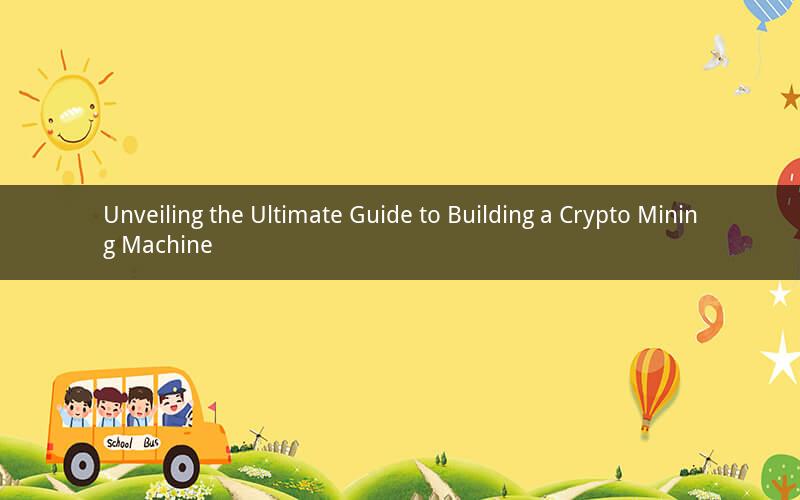
Introduction:
The cryptocurrency world has witnessed an exponential surge in its popularity over the past few years. As a result, the demand for crypto mining machines has also skyrocketed. Building a crypto mining machine might seem like a daunting task, but with the right guidance and information, anyone can embark on this exciting journey. In this comprehensive guide, we will delve into the essential aspects of constructing a crypto mining machine, ensuring you are well-equipped to embark on your mining endeavors.
1. Understanding the Basics:
To begin with, it's crucial to understand the basics of cryptocurrency mining. Crypto mining is the process of verifying and adding new transactions to a blockchain ledger. Miners are rewarded with cryptocurrencies for their efforts, and the process is powered by powerful computers known as mining rigs. Before diving into the construction of a mining machine, familiarize yourself with the following key terms:
a. Cryptocurrency: A digital or virtual currency that uses cryptography for security.
b. Blockchain: A decentralized ledger that records all transactions across a network of computers.
c. Mining Rig: A computer system specifically designed for cryptocurrency mining.
2. Selecting the Right Hardware:
The hardware you choose for your mining machine plays a crucial role in its performance and profitability. Here are some essential components to consider:
a. Graphics Processing Unit (GPU): GPUs are the most popular choice for crypto mining due to their high processing power. Popular GPU models include NVIDIA's GeForce RTX 3090 and AMD's Radeon RX 6800 XT.
b. Motherboard: Ensure the motherboard you choose has ample expansion slots, sufficient RAM, and support for the required GPUs.
c. Power Supply: Invest in a reliable power supply unit (PSU) with sufficient wattage to power your entire rig. It's advisable to go for an 80 Plus Gold or Platinum certified PSU for efficiency.
d. Cooling System: Efficient cooling is vital to prevent overheating and ensure the longevity of your hardware. Consider using high-quality air or liquid coolers.
e. Storage: Solid State Drives (SSDs) are preferred for their speed and reliability. A 500GB or 1TB SSD should suffice for storing your operating system and necessary software.
f. Case: A robust and well-ventilated case is essential to house your hardware and provide proper airflow.
3. Installing the Operating System:
Once you have all the hardware components, the next step is to install the operating system (OS) on your SSD. The most popular choice for crypto mining is Linux, specifically Ubuntu or its derivatives. Follow these steps to install the OS:
a. Obtain a USB drive with a bootable Ubuntu ISO image.
b. Boot your system from the USB drive.
c. Follow the on-screen instructions to install Ubuntu on your SSD.
d. Customize the installation process to meet your specific requirements.
4. Configuring the Mining Software:
After installing the OS, it's time to configure the mining software. There are various mining software options available, but some popular choices include CGMiner, NiceHash, and Claymore's Ethereum miner. Here's a step-by-step guide to setting up CGMiner:
a. Install CGMiner by running the following command in your terminal:
```
sudo apt-get install cgminer
```
b. Configure CGMiner by editing the `cgminer.conf` file:
```
nano /etc/cgminer/cgminer.conf
```
c. Modify the necessary parameters, such as pool address, username, and password, to connect to a mining pool.
d. Save the file and exit the text editor.
e. Start CGMiner by running the following command:
```
cgminer -o -u -p
```
5. Joining a Mining Pool:
Joining a mining pool is highly recommended for solo miners due to the increasing difficulty of mining cryptocurrencies. Mining pools allow miners to work together, combining their computing power to solve blocks and share the rewards based on their contribution. Research and select a reputable mining pool that aligns with your preferences.
6. Monitoring and Maintenance:
Regular monitoring and maintenance are crucial to ensure optimal performance and longevity of your mining machine. Keep an eye on the following aspects:
a. Hardware temperature: Overheating can damage your components. Use software like HWMonitor or SpeedFan to track temperatures.
b. Power consumption: Monitor your electricity bill and ensure your power supply is sufficient for your rig.
c. Mining profitability: Stay updated with the current market trends and adjust your strategy accordingly.
d. OS updates: Regularly update your OS to ensure security and performance.
Q1: Can I mine cryptocurrencies using a CPU instead of a GPU?
Answer: While CPUs can be used for mining, they are significantly less efficient compared to GPUs. GPUs are specifically designed for parallel processing, making them the preferred choice for crypto mining.
Q2: How long does it take to mine a cryptocurrency?
Answer: The time required to mine a cryptocurrency varies depending on the algorithm, network difficulty, and the power of your mining rig. On average, mining a single block can take several hours to several days.
Q3: Can I mine multiple cryptocurrencies with a single mining rig?
Answer: Yes, you can mine multiple cryptocurrencies using a single mining rig. However, it's essential to consider the profitability of each coin and prioritize the ones that offer the best returns.
Q4: How can I determine the profitability of my mining rig?
Answer: To determine the profitability of your mining rig, use mining profitability calculators available online. These tools take into account the hardware specifications, electricity costs, and current market prices of cryptocurrencies.
Q5: Can I mine cryptocurrencies without a mining rig?
Answer: While it is technically possible to mine cryptocurrencies using your computer's CPU, it is not practical or profitable due to the low performance of CPUs compared to specialized mining hardware.